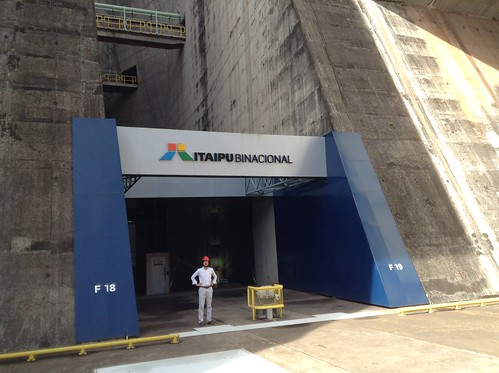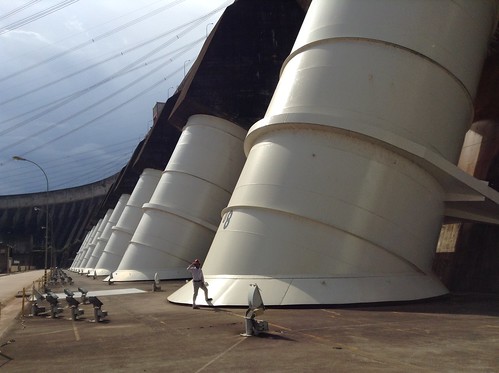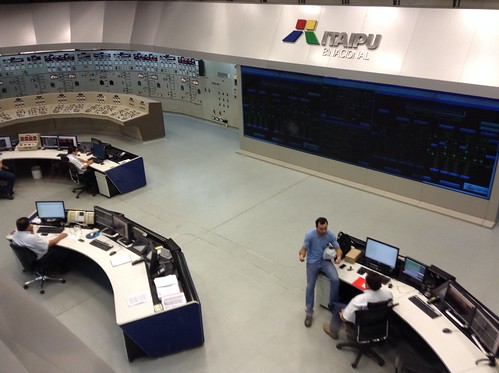
“It’s incredible,” I said. “I’ve never seen a bigger dam.”
“Neither have I,” replied the Brazilian chief of staff for Itaipu Dam, which was for decades the world’s No. 1 energy-generating hydropower plant (a few weeks ago, it was surpassed by China’s Three Gorges Dam).
Five miles wide, 65 stories tall, and made from enough concrete to build 210 replicas of the 80,000-seat Maracanã soccer stadium in Rio de Janeiro, as well as enough iron and steel to construct 380 Eiffel Towers, Itaipu Dam is one of the most impressive man-made projects I’ve ever seen in person.
Located on the border with Paraguay and not far from the famous Iguaçu Falls, the dam was completed in 1984 after a decade of construction and since been named one of seven wonders of the modern world and been honored with a 39-minute cantata written by the American composer Philip Glass.

But now, with Itaipu’s electricity production waning in recent years because of low river levels, this dam is also a glaring symbol of Brazil’s need to diversify its energy sources amid a major drought that is depleting hydropower reservoirs across the country and tipping Latin America’s largest nation into crisis, as I wrote for Americas Quarterly yesterday. Hydropower supplies three-fourths of all electricity used in Brazil compared to only 6 percent in the US.
Earlier this month I visited the three-decade-old hydroelectric power plant and met with chief of staff David Rodrigues Krug. He described his work at Itaipu as like chasing a unicorn: he wants to surpass 100 billion kilowatt hours of power generation in a single year (something that even Three Gorges hasn’t yet done), but he can never quite catch that number.

To give a sense of how much energy is 100 billion KWh: it’s 25 times as much electricity as produced every year at the Hoover Dam, and equivalent to the energy produced from burning 536,000 barrels of oil every day for a year at a thermoelectric plant. And yet, when you visit Itaipu in person, it’s hard to not be overwhelmed by the amount of power this dam is generating nonetheless. Everything about the dam is just so damn huge, from the 35-foot-wide penstocks that feed water into the structure to the 20 massive turbines spinning at 91.6 rev/min.
I couldn’t help but feel kid-like wonder. Even small details were fascinating. In the elevator, floors were labeled not by level but by elevation in meters above the sea. Beats me as to why.


Below is a video I took of one of the plant’s 20 turbines. I was so close that I could have touched it. I could have sabotaged it, I thought. Children under the age of 14 are not allowed inside the plant, perhaps because they may have slightly less inhibition about actually touching those turbines.

Throughout the tour I kept asking my guide, “What’s that do? And what’s that do? How fast is that spinning? Would I die if I jumped into the water here?” And in reality, people have died at Itaipu: there have been 149 construction-related deaths, 80 spectators were killed in a related bridge accident, and 40,000 people were displaced by the dam’s reservoir…
And then there’s the demise of the waterfall that used to be here as well as the destruction of the natural habitat for an untold number river and land species. Itaipu didn’t even bother to create any type of fish-migration bypass until the past decade. The fish-ladder was dry when I visited. (For a deeper sense of the negative environmental impacts on river systems from dams, check out the 2014 documentary DamNation.)
That said, Itaipu produces so much energy for the world’s fifth most-populous nation, it’s hard to imagine what Brazil would do without it. The plant is projected to have a 200-year life span, which means another 170 years for Krug to chase down that unicorn.
